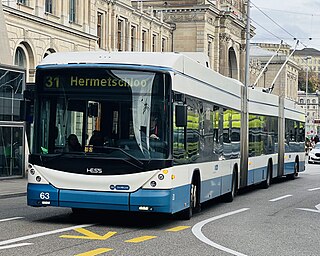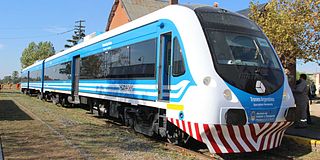
A trolleybus is an electric bus that draws power from dual overhead wires using spring-loaded trolley poles. Two wires, and two trolley poles, are required to complete the electrical circuit. This differs from a tram or streetcar, which normally uses the track as the return path, needing only one wire and one pole. They are also distinct from other kinds of electric buses, which usually rely on batteries. Power is most commonly supplied as 600-volt direct current, but there are exceptions.

Transport in Argentina is mainly based on a complex network of routes, crossed by relatively inexpensive long-distance buses and by cargo trucks. The country also has a number of national and international airports. The importance of the long-distance train is minor today, though in the past it was widely used and is now regaining momentum after the re-nationalisation of the country's commuter and freight networks. Fluvial transport is mostly used for cargo.

Rosario is the largest city in the central Argentine province of Santa Fe. The city, located 300 km (186 mi) northwest of Buenos Aires on the west bank of the Paraná River, This city is the third-most populous city in the country after Buenos Aires and Cordoba. With a growing and important metropolitan area, Greater Rosario has an estimated population of 1,750,000 as of 2020. One of its main attractions includes the neoclassical, Art Nouveau, and Art Deco architecture that has been preserved in hundreds of residences, houses and public buildings. The city is also famous for being the birthplace of the legendary Argentine footballer Lionel Messi.

AS Oslo Sporveier is a defunct municipal owned company responsible for public transport in Oslo, Norway. It was created in 1924 to take over the city's two private tram companies. In 1927 its started with bus transport, including from 1940 to 1968 trolleybuses. Since 1966 rapid transit and from 1985 water buses have also been operated by the company. It was split into two separate companies in 2006; Kollektivtransportproduksjon took over the operation while Oslo Public Transport Administration was responsible for buying the services, fare regulation and marketing. The latter merged into Ruter in 2008, when the Oslo Sporveier brand was discontinued.
Azienda Trasporti Milanesi S.p.A. is the municipal public transport company of Milan and 46 surrounding metropolitan municipalities. It operates 5 metro lines, 17 tram lines, 122 bus lines and 4 trolleybus lines, carrying about 776 million passengers in 2018.

Servicio de Transportes Eléctricos de la Ciudad de México (STE) is a public transport agency responsible for the operation of all trolleybus and light rail services in Mexico City. As its name implies, its routes use only electrically powered vehicles. It was created on 31 December 1946 and is owned by the Mexico City government. STE is overseen by a broader local governmental authority, Secretaria de Movilidad de la Ciudad de México (SEMOVI)(Secretariat of Mobility of Mexico City), formerly (SETRAVI) which also regulates the city's other public transport authorities, including Sistema de Transporte Colectivo, Red de Transporte de Pasajeros del Distrito Federal and Metrobús, as well as other forms of transportation in the district. STE's passenger vehicle fleet consists exclusively of trolleybuses, light rail, and aerial lift vehicles, and in 2007 its network carried 88 million passengers, of which 67 million were on trolleybus services and 21 million on light rail.

Trolleybuses in São Paulo provide a portion of the public transport service in Greater São Paulo, in the state of São Paulo, Brazil, with two independent trolleybus systems. The SPTrans system opened in 1949 and serves the city of São Paulo, while the Empresa Metropolitana de Transportes Urbanos de São Paulo (EMTU) system opened in 1988 and serves suburban areas to the southeast of the city proper. Worldwide, São Paulo is the only metropolitan area possessing two independent trolleybus systems.

The Santos trolleybus system forms part of the public transport network in Santos, a municipality in the state of São Paulo, Brazil. Opened on 12 August 1963, it presently comprises only one line, and, along with the two São Paulo metropolitan area trolleybus systems, is one of only three trolleybus systems still operating in Brazil.

The Shanghai trolleybus system is a system of trolleybuses forming part of the public transport network in the city of Shanghai, China. Of more than 300 trolleybus systems in operation worldwide, the Shanghai system is the oldest. The system turned 100 years old in November 2014 and was the first trolleybus system anywhere in the world to reach that milestone.

The Solingen trolleybus, also known locally as Stangentaxi, serves the city of Solingen, in the federal state of North Rhine-Westphalia, Germany.

The Córdoba trolleybus system is part of the public transport network in Córdoba, the capital city of Córdoba Province, Argentina.

The Rosario trolleybus system is part of the public transport network in Rosario, the largest city in the province of Santa Fe, Argentina.

The Zurich trolleybus system is part of the public transport network of Zurich, Switzerland. Opened in 1939, it combines the Zurich S-Bahn, the Zurich tramway network and Zurich's urban motorbus network to form an integrated all-four style scheme.

The Lyon trolleybus system is part of the public transport network of the city and commune of Lyon, France. Opened in 1935, it combines with the Lyon Metro, the Lyon tramway network and Lyon's urban motorbus network to form an integrated system.

Trasporti Pubblici Luganesi (TPL) is a public transport operator in and around the Swiss city of Lugano. Previously known as the Società luganese dei tramway elettrici, Tranvie elettriche comunali, Azienda comunale del traffico (ACT) and Azienda comunale dei trasporti della Città di Lugano (ACTL), the organisation was founded in 1884 and adopted its current name in 2000.
As of 2012 there were around 300 cities or metropolitan areas where trolleybuses were operated, and more than 500 additional trolleybus systems have existed in the past. For complete lists of trolleybus systems by location, with dates of opening and closure, see List of trolleybus systems and the related lists indexed there.

Materfer is an Argentine manufacturer of railway and road vehicles, located in the city of Ferreyra in Córdoba Province. The company was established by Fiat Concord in the late 1950s, being its subsidiary until 1980 when Sevel Argentina took over Fiat vehicles.
The Rosario Tramway was a planned mass transit tramway network in Rosario, Argentina. Nevertheless, the project never surpassed the bidding process stages. The project was assessed by Ferrocarrils de la Generalitat Valenciana and was largely inspired by the network the company runs in Valencia, though at one point a metro system was envisioned. The municipal and provincial governments undertaken discussions with the Industrial and Commercial Bank of China for financing the project, as well as Siemens to provide the rolling stock. Once the project was completed, it would be the first time trams have run in the city on a mass scale since the closure of the city's tramway network in 1963, which had reached a maximum extension of 192 km.

The Sistema Integral de Tren Ligero (SITREN) is the semi-articulated bus service which feeds the Sistema de Tren Eléctrico Urbano in Jalisco, Mexico. It started operations on January 5, 2007. It serves the municipalities of Guadalajara, Zapopan and Tonalá.
















